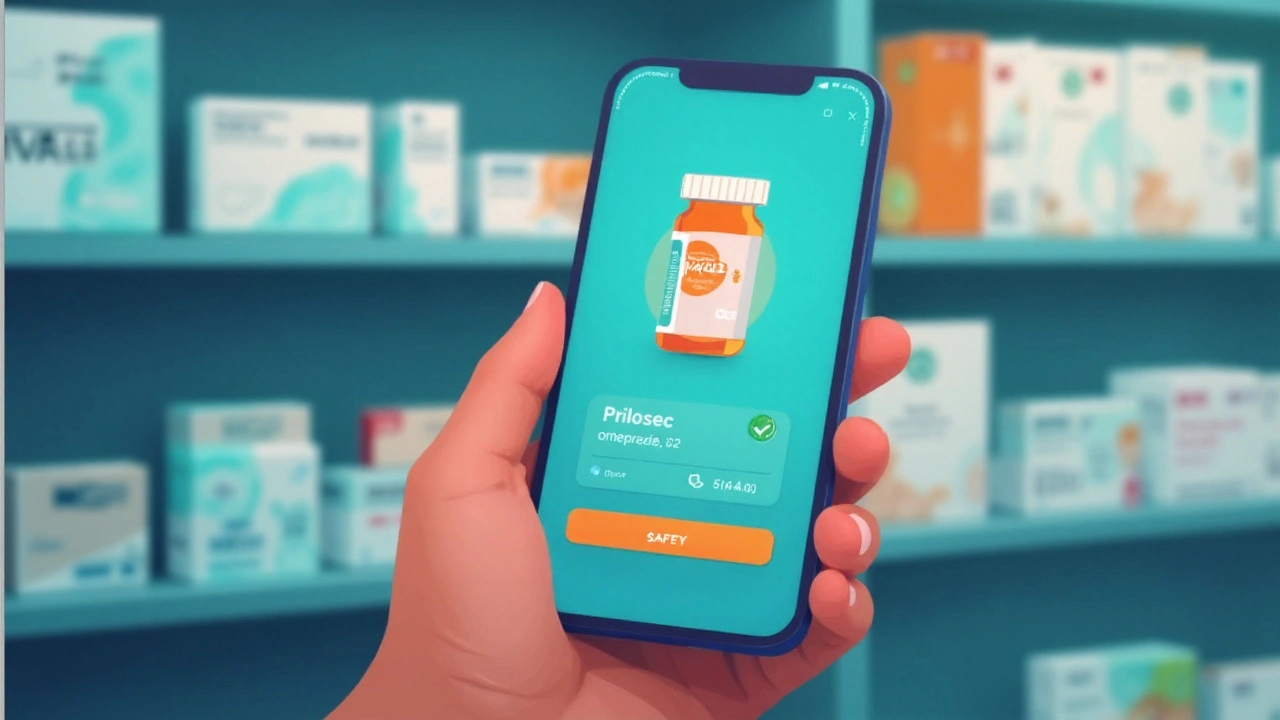
Health September 25, 2025
How to Buy Cheap Generic Prilosec Online Safely
Generic Prilosec is a low‑cost version of the proton‑pump inhibitor omeprazole, used to treat acid‑related conditions such as heartburn and gastro‑esophageal reflux disease (GERD). Active ingredient: omeprazole, Typical dose: 20mg daily. Proton Pump Inhibitor (PPI) is a drug class that suppresses stomach acid by blocking the H⁺/K⁺‑ATPase enzyme. In the UK, the FDA (Food and Drug Administration) or its UK equivalent, the MHRA, regulates the safety and labeling of all oral medications, including generics. Buying medicine on the internet means dealing with an Online Pharmacy a licensed retailer that sells prescription and over‑the‑counter drugs via a website.. The Prescription Requirement is the legal rule that most PPIs need a valid doctor’s prescription before they can be dispensed, although some low‑dose versions may be sold OTC in certain jurisdictions.
TL;DR - Quick Takeaways
- Generic Prilosec (omeprazole) is the cheapest way to treat heartburn.
- Only buy from pharmacies that show a valid UK registration number.
- Compare price per 30‑tablet supply - most cheap sites charge £4‑£7.
- Check for a proper prescription or a qualified tele‑health consultation.
- Watch for interactions with blood thinners, clopidogrel, and ketoconazole.
Why Choose Generic Prilosec Over the Brand?
The brand version, Prilosec, costs roughly 2‑3× more than the generic because you’re paying for the trademark, packaging and marketing. Bio‑equivalence studies, published by the British Pharmacopeia, confirm that the generic delivers the same plasma concentration within a 10% margin, which is the legal standard for drug substitution.
For a typical 30‑tablet pack:
- Brand Prilosec: £18‑£22
- Generic (omeprazole): £4‑£7
- Other PPIs (e.g., Nexium, Prevacid): £9‑£13
That price gap translates into real savings for anyone with chronic reflux, especially if you need a year‑long supply.
Legal Landscape: What the Regulator Says
The UK’s Medicines and Healthcare products Regulatory Agency (MHRA) follows the same principles as the FDA: a generic must prove bio‑equivalence, purity and manufacturing consistency before it can be marketed. Look for the EU‑GMP (Good Manufacturing Practice) seal on the product page - it signals that the batch was inspected by an authorized body.
If a site claims that the medication is “prescription‑free” without a tele‑health consult, treat it as a red flag. The MHRA can fine illegal sellers up to £500,000 and seize inventory.
Finding a Trustworthy Online Pharmacy
Not all websites are created equal. Use the following checklist before you click ‘Add to Cart’:
- Verify a UK registration number (e.g., GPhC for pharmacists or MHRA licence 12345).
- Ensure the site uses HTTPS encryption - look for the padlock icon.
- Check for a visible pharmacist’s contact details and a physical address in the UK.
- Read the privacy policy - it should outline how your prescription data is stored.
- Confirm that the pharmacy offers a clear return or refund policy for medication errors.
Popular UK‑based platforms that meet these criteria include Pharmacy2U, LloydsPharmacy Online, and Well Pharmacy. They often have a tele‑health service that issues a prescription after a brief questionnaire.
Price Comparison Table
| Product | Active ingredient | Price (GBP) | Prescription needed? |
|---|---|---|---|
| Generic Prilosec | Omeprazole 20mg | £5.99 | Yes - tele‑health OK |
| Brand Prilosec | Omeprazole 20mg | £20.49 | Yes |
| Nexium (Esomeprazole) | Esomeprazole 20mg | £12.75 | Yes |
| Prevacid (Lansoprazole) | Lansoprazole 30mg | £10.20 | Yes |

Safety First: Interactions & Side Effects
While omeprazole is well‑tolerated, it can affect the absorption of certain nutrients (vitamin B12, magnesium) and interact with drugs that rely on stomach acidity. Key interactions to watch:
- Clopidogrel - omeprazole may reduce its antiplatelet effect.
- Warfarin - monitor INR more closely.
- Ketoconazole - reduced antifungal absorption.
If you’re on any of these, talk to your GP or a qualified pharmacist before starting the medication. Common side effects include mild headache, nausea, or flatulence, usually clearing after two weeks.
How to Take Generic Prilosec Correctly
Follow these simple steps for optimal acid control:
- Take one tablet with a full glass of water 30‑60 minutes before breakfast.
- Avoid crushing or chewing - it’s designed for release in the stomach.
- If prescribed twice daily, keep the second dose at least 12hours apart.
- Do not discontinue abruptly after long‑term use; taper to every other day for one week under medical guidance.
Storing the tablets in a cool, dry place prolongs potency up to 24months from the manufacture date printed on the blister pack.
Tips to Maximise Savings
- Buy in bulk - a 90‑tablet pack from a reputable UK pharmacy often costs ≈£15, a 30‑tablet pack is ~£5.
- Look for discount codes on health‑forum threads; many sites offer a 10% first‑order coupon.
- Subscribe to a medication delivery service; they usually shave another £1‑£2 per order.
- Check if your private health insurance covers PPIs; some policies reimburse up to £30 per prescription.
- Use price‑comparison apps that scrape NHS and private pharmacy listings.
Related Health Topics You Might Explore Next
Understanding Acid Reflux the backward flow of stomach contents into the esophagus, causing heartburn can help you decide if lifestyle changes might reduce reliance on medication. Other useful reads include:
- Dietary triggers for GERD (citrus, chocolate, caffeine).
- When to switch from over‑the‑counter PPIs to a prescription‑strength regimen.
- Long‑term safety of daily PPI use - recent UK gastro‑enterology studies.
Frequently Asked Questions
Is it legal to buy generic Prilosec online without a prescription?
In the UK, omeprazole is classified as a prescription‑only medicine (POM). You can purchase it online if the pharmacy provides a tele‑health consultation that results in a valid prescription. Sites that claim “no prescription needed” are likely operating illegally.
How much does cheap generic Prilosec cost compared to the brand?
A 30‑tablet pack of generic omeprazole typically sells for £5‑£7, whereas the brand Prilosec costs £18‑£22. The price difference is due to branding and marketing, not efficacy.
What should I look for to spot a reputable online pharmacy?
Check for a UK licence number (e.g., GPhC or MHRA), HTTPS encryption, a visible pharmacist contact, clear privacy and return policies, and evidence of tele‑health services that can issue a prescription.
Can I take generic Prilosec with other medications?
Yes, but there are notable interactions. Omeprazole can reduce the effectiveness of clopidogrel, alter warfarin levels, and decrease absorption of certain antifungals. Always discuss your full medication list with a pharmacist.
How long should I stay on generic Prilosec?
Short‑term use (4‑8 weeks) is safe for most people. If symptoms persist longer, a doctor may recommend a maintenance dose or investigate underlying conditions like Barrett’s esophagus.
Write a comment
Items marked with * are required.






13 Comments
Vandita Shukla September 25, 2025 AT 06:36
Anyone still browsing sites without a UK licence number is basically gambling with their stomach lining. The MHRA registration is not a decorative badge; it guarantees the batch has passed bio‑equivalence testing and GMP inspection. Skip the cheap‑look offers that hide behind generic “no prescription needed” promises, because they often source from unregulated compounding labs. A legitimate pharmacy will display a GPhC or MHRA licence right on the footer, and you can verify it through the official register. Trust the checklist, not the flashy discount code.
Susan Hayes September 28, 2025 AT 17:56
What the UK folks don’t get is that American online pharmacies have been vetted by the FDA for decades, and most of them operate under strict tele‑health protocols. If a US site shows the .gov verification seal and a board‑certified physician’s signature, that’s a solid signal you’re not getting a counterfeit. The drama of “British licences” is just a marketing ploy to make consumers feel unsafe. Our own health regulators are equally tough, so you can have confidence in a reputable US provider. Bottom line: don’t let nationalism dictate where you shop for omeprazole.
Jessica Forsen October 2, 2025 AT 05:16
Sure, the checklist looks like a bureaucratic nightmare, but it’s actually a decent safety net. If you compare the price‑per‑tablet of a site that hides its licence with one that proudly displays it, you’ll see the cheap option often cuts corners on quality. It’s kind of funny how some people think “cheaper = better” when it comes to meds. Keep an eye on the pharmacist’s contact details – they’re usually the first line of defense against shady operations. In the end, a little extra time saves a lot of stomach trouble.
Deepak Bhatia October 5, 2025 AT 16:36
Just follow the checklist and you’ll be fine.
Samantha Gavrin October 9, 2025 AT 03:56
There’s a hidden agenda behind the “official” pharmacy listings – big pharma companies fund regulators to keep the cheap generics off the mainstream radar. They whisper that only brand‑name drugs are “safe,” while the generic market is flooded with sub‑therapeutic doses that barely relieve heartburn. If you look at the supply chain, many of those “licensed” UK sites are actually subsidiaries of multinational corporations that disguise profit motives as patient care. The truth is, the more you dig, the more you see the system protecting its own pockets.
NIck Brown October 12, 2025 AT 15:16
Spreading conspiracy theories does no one any favors, especially when most online pharmacies operate under transparent audits and are subject to real penalties for violations. Your blanket distrust ignores the thousands of pharmacists who run compliant services and actually help patients manage reflux. It’s unhelpful to paint every regulator as a puppet, and it distracts from genuine safety concerns like verifying the MHRA licence. Let’s focus on concrete red flags instead of vague allegations.
Andy McCullough October 16, 2025 AT 02:36
When assessing the pharmacokinetic profile of omeprazole, it’s essential to consider both the acid‑stable enteric coating and the cytochrome‑P450 mediated metabolism, particularly CYP2C19 polymorphisms that can alter plasma AUC by up to 40 %. The generic formulation must demonstrate bio‑equivalence within the 80‑125 % confidence interval for Cmax and AUC, as mandated by the EMA guideline, which is routinely verified through fed and fasted state studies. In practice, this means the generic tablet achieves a similar intragastric pH elevation curve, maintaining a pH > 4 for approximately 60 % of the dosing interval, comparable to the branded reference. Moreover, the excipient matrix in reputable generics is designed to prevent premature drug release, safeguarding against degradation in the acidic milieu of the stomach. From a clinical perspective, the therapeutic endpoint-reduction in esophageal acid exposure-remains statistically indistinguishable between brand and generic when adherence is consistent. It’s also worth noting that drug‑drug interaction potential is largely dictated by the enzyme inhibition profile; omeprazole’s reversible inhibition of CYP2C19 can diminish the activation of clopidogrel, necessitating monitoring of platelet function tests in high‑risk patients. Conversely, the interaction with warfarin is mediated through altered vitamin K metabolism, which can be mitigated by more frequent INR checks during the initiation phase. For patients on ketoconazole, concurrent omeprazole therapy can reduce its solubility, so dosage adjustments or alternative antifungals may be required. The safety monitoring schedule should therefore incorporate baseline and periodic assessments of serum magnesium and vitamin B12 levels, given the documented risk of long‑term deficiency. From an economic standpoint, bulk purchasing of generic omeprazole yields a cost reduction of roughly 70 % compared to the branded counterpart, translating into a favorable cost‑effectiveness ratio in health‑technology assessments. Insurance formularies often tier generics as first‑line therapy, reflecting both clinical equivalence and fiscal prudence. In regulatory terms, any deviation from the established GMP standards-such as non‑sterile manufacturing environments or undocumented batch releases-triggers immediate inspection and potential market suspension by the MHRA. Finally, patient education on proper dosing-taking the tablet 30‑60 minutes before a meal with a full glass of water-optimizes acid suppression and minimizes rebound hyperacidity upon discontinuation. By adhering to these pharmacological and regulatory principles, clinicians can confidently prescribe generic omeprazole without compromising therapeutic outcomes.
Zackery Brinkley October 19, 2025 AT 13:56
Thanks for breaking that down; it really helps to see how the science backs up the cheap option.
Luke Dillon October 23, 2025 AT 01:16
Exactly, and the cost savings mean more people can actually afford to keep their reflux under control.
Elle Batchelor Peapell October 26, 2025 AT 11:36
Ever think about how our stomach is basically a chemical lab that we’re constantly trying to keep from blowing up? It’s wild that a tiny pill can calm the acid rebellion, reminding us that balance is a daily choice. When we chase the perfect pH, we’re also chasing a kind of inner peace, a quiet moment where the fire inside doesn’t dictate our day. So maybe the real trick isn’t just the medication, but remembering to give our bodies the breaks they need-slow meals, mindful breathing, and the occasional pause from stress. In that sense, cheap generic Prilosec is just a tool, not the whole solution.
Jeremy Wessel October 29, 2025 AT 22:56
Medication works but habits matter more.
Laura Barney November 2, 2025 AT 10:16
Picture this: a rainbow of savings exploding across the pharmacy aisle as you swap out pricey brand names for their generic twins, all while your wallet does a happy dance. The only thing you’re sacrificing is the fancy logo, not the relief. Mix in a dash of savvy price‑comparison apps and a sprinkle of discount codes, and you’ve got a recipe for stomach serenity without breaking the bank. Let’s keep the conversation lively and share those hidden coupon gems that most shoppers overlook.
Jessica H. November 5, 2025 AT 21:36
While the metaphorical language adds flair, it obscures the critical regulatory considerations that must remain front and centre. The assertion that “only the logo is sacrificed” neglects the necessity of confirming batch‑specific compliance with EU‑GMP standards, which can vary despite superficial similarity. A rigorous evaluation should therefore include verification of the manufacturer’s licensing status, the presence of a validated bio‑equivalence dossier, and a review of post‑marketing surveillance data. Without such diligence, the allure of “rainbow savings” may lead consumers to inadvertently purchase sub‑standard preparations. Consequently, any promotional discourse should be balanced with a sober reminder of the due‑diligence steps outlined in the initial guide.